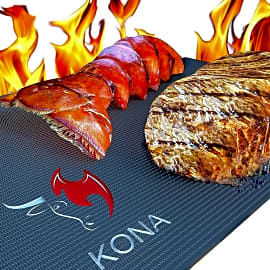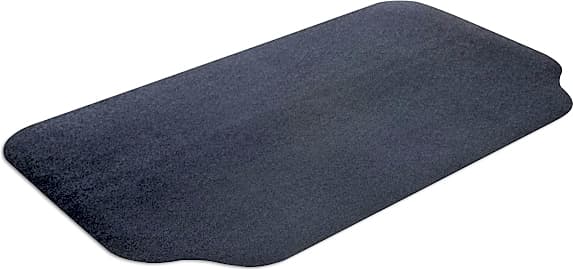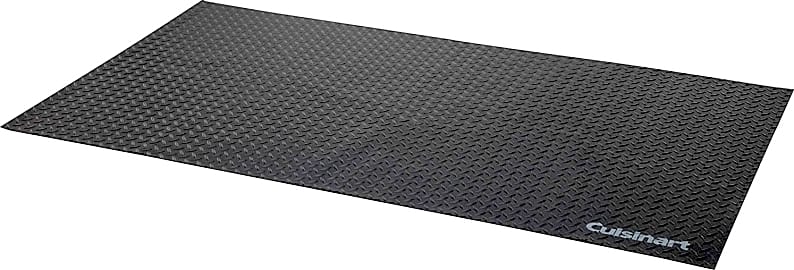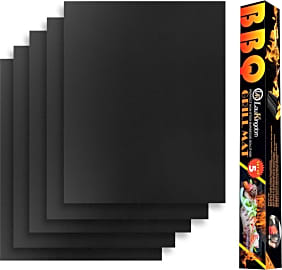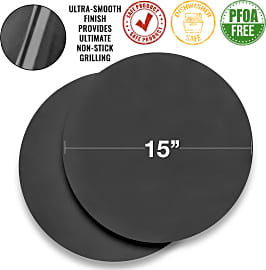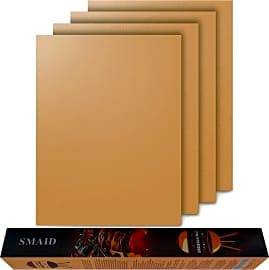The 9 Best Grill Mats

This wiki has been updated 37 times since it was first published in January of 2017. Grilling involves a lot of grease, which can cause hard-to-clean messes on the grates and sometimes on the ground. If you want to make cleanup easy without foregoing grill marks on traditional barbecues and without losing the all-important aromas in a smoker, a good mat can come to the rescue. You may also want a different kind of large one to protect your deck or patio from spills. When users buy our independently chosen editorial picks, we may earn commissions to help fund the Wiki.
Editor's Notes
April 16, 2021:
Zero changes were made during our most recent update. We're still highly confident that whether you need something for on the grill or underneath it, this wide variety of options will have something that's right for you. If you won't use them frequently but know you'll need a few different types for cooking on, the Tosuced BBQ Set is the perfect variety pack. Alternatively, if you want something that lets the classic smoke flavor shine, the Osvino Non Stick remains the top choice.
Also note that none of these are safe to use above 500 degrees Fahrenheit, or if they might come into direct contact with flames.
March 31, 2020:
Grill mats are an interesting way to keep things cleaner when it's time to barbecue. The simplest ones, like the LauKingdom Heavy Duty and Smaid MAT-008, can't be penetrated by liquids or gases, so they ensure that there won't be any food stuck to the grate whatsoever. The Grillaholics Round is a similar version that's made for the common kettle grill, and the Nickle's Arcade Kona Best is basically the high-end version of all of them. As with all of these items, you'll have to make certain they don't exceed about 500 degrees Fahrenheit. While the impermeable ones generally cleanup especially easy, their major drawback is that they prevent juices from falling into the grill, which limits the amount of complex "grilled" flavors you end up with. Also, because they reduce airflow, they can lengthen cooking times and prevent the nice, crispy, crusty grill marks that items like steak and burgers are often known for. On the other hand, they also work great as baking mats for some pastries.
If you want to ensure you get a very close culinary experience to what you'd have without the mat, but you still want to minimize sticking, the Osvino Non Stick is the way to go. It's not as perfectly easy to clean up after as the impenetrable options, but it invariably gives you a more authentic grilled flavor. It's also an excellent choice for use in smokers, even propane and electric ones. The Tosuced BBQ Set is a 5-pack that includes 2 solid and 3 mesh sheets, so it offers more versatility than the rest. Another great alternative is the Weber Style 6435, a high-end option similar to a grill basket that won't give you grill marks but will allow heat and flavorful aromas to pass through.
Also, it's important to note that these are only usable up to about 500 degrees Fahrenheit, and cannot come into contact with flames. If either of those things happen, they're very likely to break down. While PTFE isn't dangerous when ingested, it can have some bad side effects if its off-gassed vapors are inhaled, so be sure not to overheat any of these.
A Brief History Of Grilling
In fact, the word barbecue ultimately derives from an Arawak word describing a wooden structure used to roast meat.
Food plus fire seems like one of the most basic equations in human history, as well as a primary reason why our species has been so successful. Indeed, the first instance of grilling was likely a caveman tossing some wild game into a fire and taking notice of how good it smelled. If those ancestors were anything like humans today, a second caveman immediately came over and pushed him out of the way, because only he knew the "real" way to grill.
Grilling eventually became more subtle than just throwing food in a blazing pit, of course, and soon techniques for cooking over an open flame developed. The Bible mentions burning animal sacrifices because God found the smell pleasing, while the priests ate the actual meat (God got a bum deal). In fact, there are several pages of Exodus and Leviticus that go into great detail about the proper way to prepare meat over a flame.
In the East, citizens of India, China, and Japan, prepared their meat in ceramic urns called either tandoors or kamados. This allowed for slow cooking and smoking, and likely serves as the first instance of barbecue.
The Europeans devoted quite a bit of time and craftsmanship to perfecting the art of cooking beef. Elaborate mechanisms were devised to get the temperature just right, and many households had a specially-bred turnspit dog (much like the modern Corgi) whose job it was to turn a rotisserie. The Germans, meanwhile, devoted their efforts to preparing pork and sausage.
In the Americas, many native tribes had their own ideas about grilling. In fact, the word barbecue ultimately derives from an Arawak word describing a wooden structure used to roast meat.
Once settlers began pouring into the eastern United States, they developed and propagated their own grilling methods. As Manifest Destiny led to westward expansion, grilling techniques followed, leading to the regional specialties that exist today in places like the Carolinas, Texas, and Kansas City.
In the days following WWII, returning veterans moved to homes in the suburbs, complete with yards perfect for cooking and entertaining. In 1952, a metalworker named George Stephen began selling a modified harbor buoy to which he'd added a metal grate. This was the first Weber grill, and it soon became a staple of backyard cookouts across the nation.
Today, grilling is still an important part of our social and culinary structures. There's nothing quite like having a few friends over, throwing some burgers (or tofu patties) on the grill, and enjoying everyone's company.
Now move. You're burning the meat — you know what, just let me do it.
How To Use A Grill Mat
While grilling is an almost sure-fire way to make any meal delicious, sometimes it seems like more trouble than it's worth — especially when you're preparing something that's going to make a huge mess for you to clean up later.
For those meals, using a grill mat will save you lots of time and frustration. Acting somewhat like a flexible, non-stick pan, these mats go directly between the grill and your food, letting the heat through without allowing the meat or sauce to stick to the grate.
You should use a mat whenever you're cooking something especially messy, or food that you suspect will stick to the grill.
This also helps you deal with flare-ups, as there will be less fat dripping down into the fire. A grill mat makes it much easier to cook at an even temperature, especially if you're busy doing something that takes your attention away from the fire, like entertaining guests or watching children.
You should use a mat whenever you're cooking something especially messy, or food that you suspect will stick to the grill. Beyond that, you can also use them to cover up rust, cook delicate meats, or to prepare non-traditional foods like eggs or pancakes. Also, if you use public grills, a mat will protect your family from whatever contaminants might be lurking on the surface.
To use, fire up your grill and simply line it with your mats, being sure to keep them in a single layer. You then cook as you normally would, although you'll likely find the process much easier. Just be careful with metal utensils, as they can damage many mats.
Once you get the hang of using a grill mat, there's a good chance you'll never want to go back — and once your friends and family taste your perfectly-cooked meats, there's a good chance they'll never let you relinquish grilling duties.
That's enough to get you elected king in Texas.
Other Grilling Tips
One of the most important things to do when cooking over an open flame is to limit your efforts to foods that are actually suitable for grilling. That means anything that does well when cooked quickly, like burgers, brats, and seafood. While you technically can grill tougher meats like brisket or tri-tip (it's not illegal...yet), you'll get much better results by barbecuing them instead — that means cooking low and slow, over indirect heat.
Choosing your fuel — gas or charcoal — is another matter, one fraught with as much potential hostility as a conversation about politics with your in-laws.
Choosing your fuel — gas or charcoal — is another matter, one fraught with as much potential hostility as a conversation about politics with your in-laws. It's a personal preference as to which you prefer, but gas generally burns cleaner, while many people enjoy the smoky tastes that charcoal provides.
Any prep is also a matter of opinion, although using a marinade, brine, or dry rub will bring out new flavors, as well as give you a chance to experiment in the kitchen while pretending to be on a competitive cooking show.
Beyond that, it's mostly a matter of time and temperature. Unless you're a total BBQ samurai, you'll want to invest in a quality meat thermometer, as reaching the right internal temperature can mean the difference between your chicken being the talk of the party and your chicken being the focus of a personal-injury lawsuit.
Ultimately, the most important thing is that the meat tastes good; how you get there pales in comparison. Oh, and remember — anyone who complains about your grilling abilities should be immediately challenged to a duel.



